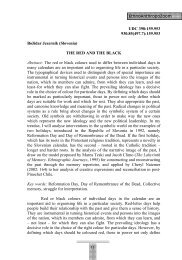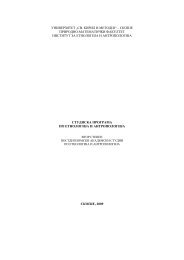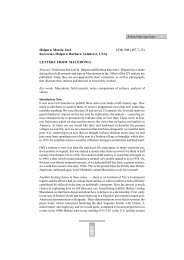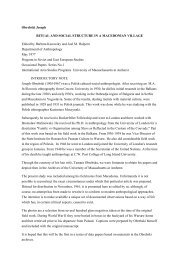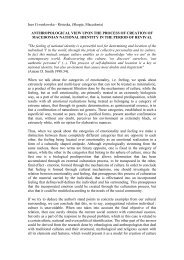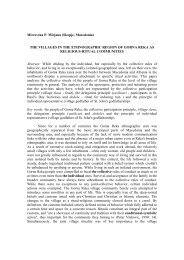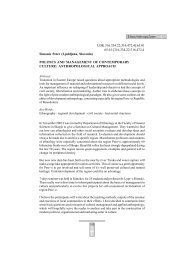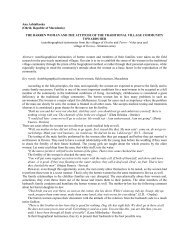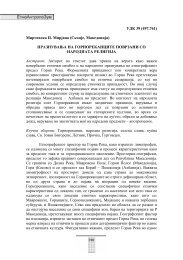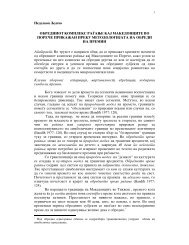Nedelkov J. Ljupco - Универзитет „Св. Кирил и Методиј“
Nedelkov J. Ljupco - Универзитет „Св. Кирил и Методиј“
Nedelkov J. Ljupco - Универзитет „Св. Кирил и Методиј“
You also want an ePaper? Increase the reach of your titles
YUMPU automatically turns print PDFs into web optimized ePapers that Google loves.
UDC 39 (497.=135.1)<br />
<strong>Nedelkov</strong> J. <strong>Ljupco</strong> (Skopje, Macedonia)<br />
THE ETHNIC CODE OF THE VLACHS AT THE BALKANS<br />
Abstract: The ethnic code is a basis for ethnic identification of each community,<br />
that separates it from other ethnic groups. Vlachs are one of the communities<br />
that have been analyzed from different aspects, with a tendency to be related to<br />
the identity of another ethnic group, without taking care about the possibility of<br />
their separate ethnic identity. They are, for example, related to the Romanians,<br />
Romans, Greeks, Thracians, Ilirians and others. However, if one takes into<br />
account the fact that all communities emerged in different historical periods and<br />
under different historical conditions, then the most suitable definition of the<br />
ethnic identity of the Vlachs would be: Vlachs are a community that has a<br />
separate ethnic code - a name, a language, anthropological features, folk<br />
costume, typical professions, mentality etc. In this sense we will try to reflect<br />
upon the specificities of the Vlachs, according to which they identify themselves<br />
as a distinctive community in the ethnic context of the Balkans.<br />
Key words: Vlachs, Aromanians, Tzintzars, Karaguns, Fasheriots, Meglen<br />
Vlachs, ethnic origin, language, ship herding, trade, craftsmanship, religious<br />
identity, distribution.<br />
In the historical records Vlachs can be found under the name<br />
Arămăni, Аrmăni. The name Aromani is based upon folk self-naming,<br />
introduced into scientific literature by Goustav Weigand (g. Weigand, 1899),<br />
who by the end of the 19 th and the beginning of the 20 th century conducted<br />
intensive field research among the Vlach population in Greece, Albania and<br />
South parts of Macedonia. This term is a derivate of the term 'romanus' - that<br />
stems from the name of the town of Rome, and later on appears as a ethnic name<br />
of the Vlach ethnic community: Români, Rumâni, Rumâri, later on adding 'a' in<br />
front of the noun - characteristic form of Aromani language - obtaining the terms<br />
Aromâni, Arumâni etc. According to Niko Popnikola, all these terms are<br />
exonyms, since the most suitable term for naming the Vlach community is the<br />
term Arm'n (plural Arm'nj) (N. Popnikola, 2006: 200).<br />
In literature the exonym Vlach (pl. Vlachs) can be also found for their<br />
collective identification. In this sense the issue rises: what is the etymological<br />
meaning of the term Vlach?<br />
Commonly accepted is the opinion according to which the etymology<br />
of the term Vlach (pl. Vlachs) stems from the Celtic tribe Volcae that lived in<br />
South-Eastern parts of Gallia (today's France) (T. G. E. Powel, 1958: 81, 141).<br />
This tribal community was divided into two branches: Arecomici and<br />
Tektosogesi. The former lived between the rivers of Rhone and Garonne, while
the latter between Rhone and the Pyrenees (Н. Вуч<strong>и</strong>чев<strong>и</strong>ħ, 1981: 318). Caesar<br />
speaks about them as Volcae, while Strabon and Ptolemy as Ouólkai (Victor A.<br />
Friedman, 2001: 1). On the other hand, traditional etymology relates the attribute<br />
Volcae to the Welsh word golchi (washes himself), Irish folk (baths), naming<br />
this tribe river people - if one takes into account that the tribe Volcae lived once<br />
near antic river Volcos after which it got its name. A number of researchers,<br />
connoisseurs of Celtic history, agree that the name of the tribe Volcae is a<br />
derivate of the Welsh word gwalch (falcon), comparing it to the Gallic personal<br />
name Catuulcus, Welsh cadwalch (hero), or literally translated military falcon,<br />
although some prefer to translate the Gallic uolko as wolf, and with a semantic<br />
extension fearless warrior - wanderer. But then the question remains<br />
unanswered: how did a term that contained a valley (river, rive people) and an<br />
aggressive-military connotation (wolf, falcon) become an identification code for<br />
a nomadic-wandering community. The answer to this question may be found in<br />
another interpretation of the word Vlach (plural Vlachs). In this sense Von Glick<br />
finds that the term Volcae is a derivate of a word related to the ancient Irish<br />
word that means fast, laborious, clever, energetic - epithets that among other are<br />
characteristic for the sheep herding ethnic communities (Henry H. Howorth,<br />
1908: 417–433). But at the beginning this terms was not related to the ship<br />
herding communities, but it became an identification code for members of<br />
different ethnic communities that lived outside their original territory.<br />
It is well known that by the end of the 4 th and the beginning of the 3 rd<br />
century B.C. the Celts migrated to the Balkans, in two waves. The first one was<br />
in 280 th BC towards Macedonia and Ilyria, while the second one included the<br />
invasion of Celts to Delphi in 279 th BC. These two invasions happened at the<br />
territory of Dardany and Macedonia. Tit Livius wrote on the second invasion:<br />
"A big and powerful migration of Gals, initiated by the poverty of their land, as<br />
well as the desire to steel, believing that there is no other ethnic group that<br />
equals then in number and military power, leaded by Bren, arrived in Dardania.<br />
Here there was conflict and separation: twenty thousand people leaded by<br />
Lenorius and Lutarius separated from Bren and went to Thrace" (T. Liv. 16:1).<br />
Other continued to Greece. In spite of the divide and the military defeats, still<br />
part of them remained at this territory, while another part, leaded by Bathanat,<br />
penetrated the Danube area, where they settled under the name of Skordians (F.<br />
Papazoglu, 1969: 209–298).<br />
It is well known that the ancient Germans named the Celtic tribes<br />
Walha, Wlach, Welsch - accenting them as foreign terms (П. Скок, 1918: 294).<br />
With the Romanization of Celts (second century BC), Germans started to use the<br />
term Walha for the Romans but also for the whole Romanized population - in<br />
the sense of foreigners, people that speak another, Romanic language. Even<br />
today the German population in Switzerland uses for their French and Italian copatriots<br />
a term Welchen. The Romanian population that lies in the region of<br />
today's Eastern Belgium accepted the term Walha as their ethnic name in the<br />
form of Valonians (Walons), while the Italian population in Poland is named
Wlochy (Victor A. Friedman, 2001: 1). At the beginning of the middle ages the<br />
Slavs from Eastern Europe have taken from the Germans the term Walha<br />
(ancient Germanic variant of the term Walah), as a name that denotes the whole<br />
Romanian and Romanized population in the form Vlakhi, i.e. Vlasi in the South-<br />
Slavic languages, Volokhi in the Eastern-Slavic languages and Wlochy in Poland.<br />
Later on, through the Balkan Slavs, this term was domesticated in Greek<br />
language as well. Lately it is considered that the term Vlach entered Greek<br />
language directly through the Germanic i.e. the Scandinavian personal guards of<br />
the Byzantium tsar (Z. Merdita, 2007: 257).<br />
In South-Eastern Europe the Romanized population, searching for<br />
salvation from the invasion of the barbarians, started to escape in the mountains,<br />
where they commenced with nomadic ship herding. Thus, somewhere from the<br />
11 th century the term Vlach is related to the ship herding ethnic communities, no<br />
matter the ethnic group to which they belong. Thus, for example, in Greece this<br />
term included all sheep herding nomads, no matter if they were ethnic Vlachs, or<br />
members of another ethnic community, so in this sense the word Vlach means<br />
stock-breeder, shepherd (Д. Антон<strong>и</strong>јев<strong>и</strong>ħ, 1982: 21). In Albania the word Vlach<br />
is a synonym of shepherd (Victor A. Friedman, 2001: 1). A similar opinion is<br />
shared by the Greek researcher Hrispou who says that the name Vlach denotes a<br />
shepherd. However, he thinks that this name is phonetic and created on the<br />
territory of Greece. It was created by people from the mountains that settled<br />
there as military guards, but became shepherd due to an emerged need. Maybe<br />
due to the every-day contact with the sheep that make the distinctive sheep sound<br />
'bee' which in Greek is noted as blēchē, that is blēchōmai, or current terms<br />
belagma, belasō wherefrom the words blēchos or blachos stem from, which<br />
means imitating the sheep voices by the shepherds in order to return the lost ship<br />
from the mountain. This is where the name Vlachos came from - shepherd.<br />
Antonios Karamopoulos finds that this term stems from the word fellachos -<br />
name by which the Felasi were called, members of the pre-anthis Pelasgians,<br />
that lived at the Balkans. This opinion did not gain support with other scientists,<br />
so that the author himself corrected himself in relation to this thesis (taken from:<br />
В. Ј. Трпкоск<strong>и</strong>, 1986: 13). According to Tomashek, the name Vlach was first<br />
registered at the Balkans in the 7 th century, in a note found in the monastery of<br />
Konstamonitou on Mount Athos, Halkidiki, where the name Vlach was related<br />
to the Rinhins - blachorynchioi – settled around river Rinhos (taken from В. Ј.<br />
Трпкоск<strong>и</strong> 1986: 24). Later, this terms gained a certain pejorative connotation.<br />
For example, during Turkish rule in Bosnia (1459-1878), Muslims called the<br />
Orthodox Serbs Vlachs. The Croatians - Catholics called the whole Orthodox<br />
population Vlachs, especially when they wanted to humiliate it - in the sense of<br />
shepherds (Ст. Станојев<strong>и</strong>ħ, 1929). Thus we can conclude that the name Vlach is<br />
an exonym, with a changeable philological and ethnological meaning.<br />
However, if we start from the data of travelers (mostly F. C. H. L.<br />
Pouquevilla, 1826: 333–397; A. J. B. Wace, M. S. Thompson, 1972; W. M.<br />
Leake, 1835: 274–311 and others), that traveling through Vlach territories got to
know their life, the social structure, economy, spiritual and material culture, but<br />
also the fact that Vlachs comprise of different tribal communities that differ<br />
between each other, not only according to their character but also their<br />
mentality, then one should not be surprised by the great number of names related<br />
to this ethnic community.<br />
Thus, for example in Greece, i.e. in Acarnania, we note the name<br />
Pistiki, that reffers to a smaller group of Aromanians from Aetolia and<br />
Akarnania. The same name is noted in Asia Minor, where its carriers became<br />
Greeks, as with the example of Aromanians in Boeotia that call themselves<br />
Bomi (Z. Merdita, 2007: 250).<br />
In Athica and Beotia, the name Vlach, no matter if it refers to an<br />
Albanian or an Aromanian, means villager. Another name is used for both<br />
communities, and that is Vlachipimenes (Z. Merdita, 2007: 250). Greeks called<br />
them also Vlachs and Kucovlachs 1 , and the term Cipani is also used, especially<br />
concerning those Vlachs whose women wear big scarves reaching to the<br />
shoulders. However, a Vlach tribe with such a name does not exist (Z. Merdita,<br />
2007: 251). The name Kopashtars refers to those Vlachs that retained their<br />
customs, the laws and the costume, but instead of speaking Vlach they speak<br />
Greek language. Although these Vlachs without any doubt have Vlach origin,<br />
still they are hated by other Vlachs and in pejorative sense are called "Vlach<br />
bustards" since they have forgotten the Vlach language.<br />
The Vlachs in Albania are known under different names:<br />
ArvanitoVlachs, Kogs, Romers and Dots, since they often use the word dot<br />
meaning 'nothing', while for the same word the Karaguns use the word hič<br />
„nothing“ or dip with the same meaning. The Vlachs shepherds from Thessaly<br />
that as a tribe belong to the Fasheriots call them Katshauns and Boi, while the<br />
ones that deal with agriculture are called Mocens. Fasheriots in South Epirus are<br />
called Kambus, since they spend the winter West from Arta in Kamposi, while<br />
the Gura and Tzuli that lived in Southern Albania also belong to this community<br />
(Z. Merdita, 2007: 250). The Vlachs in Albania are known in Albanian as<br />
1 Spiros Papageorgiou finds that the name KucoVlachs is a mixture of two elements:<br />
first, as a diminutive, comprises of the word 'kuco' meaning 'imperfect, wounded,<br />
broken, something that limps', and the second - Vlachs, that refers to the Vlach ethnic<br />
community (S. Papageorgiu, 1909). According to another theory, exonym KucoVlachs<br />
stems from a group of Vlachs that participated in the Crusades. As crusaders they carried<br />
a cross that is pronounced in Vlach language as 'kruce', and thus gained the name<br />
KrucoVlachs. According to a folk legend, when Vlachs were called upon to serve the<br />
Roman army, they agreed to limp on one leg so that they would not be recruited in the<br />
Roman army corpus, and thus gained the name KucoVlachs (Б. Коч<strong>и</strong>шка, 2004: 23).<br />
Another variant of the name KucoVlachs relates it to a person that spoke bad, incorrect<br />
Greeks, thus being handicapped, limping, ignorant. Bladacci finds that the term<br />
KucoVlachs originates from the times of Turkish conquests. Namely, calling them<br />
KucoVlachs or Small Vlachs, the Turks wanted to make a difference between them and<br />
the inhabitants of Romania - Big Vlachia (A. Baldacci, 1932: 36).
Rëmeri - term stemming from the Latin Romani. In Albania Vlachs are named as<br />
„Llaciface“ - term with a pejorative connotation.<br />
In Serbia the city Vlachs are referred as Tzintzars. 2 In Bulgaria they<br />
are named Vlachs, Vlachi, Vlai, while in Turkey they are known as Vlach, Olah<br />
and Chobani, and the Romanians use the terms Aromanians or<br />
Macedoromanians for the Vlach ethnic community.<br />
Vlachs in the middle ages are found under the name Mavrovlachs,<br />
term that is often mentioned in the Dalmatian sources from the 13 th century,<br />
together with the terms Vlach and Blah 3 , while in the North-west part on the<br />
territory from Rieka to Trieste, around mountain Uchka in the region of<br />
Chicherija as Chici or Chiribirci. 4<br />
Depending on the geographic origin, Vlachs from the Balkan also<br />
have different names. Vlachs from Albania are known as Muzakiri (Vlachs from<br />
Muzakia), Farsheriots (Vlachs from the area Farsheri) and Moskopols (Vlachs<br />
from Moskopole). In Greece we find the terms: Pindens (concentrated around<br />
mountain Pindos), Gramostyans (Around mountain Gramos), Epiriots (Vlachs<br />
from Epirus), Olympians (around mountain Olympus) and Megleni (Vlachs from<br />
Meglen). In Macedonia they are known as Krushevjani (Vlachs from Krushevo),<br />
2 Instead of the name Tzintzar that has a pejorative meaning and stems from the way<br />
number five is pronounced - tzintzi, i.e. chinch, as it was pronounced by other<br />
Romanians (Д. Ј. Попов<strong>и</strong>ħ, 1937: 8–16). Winnifrith says that the name Tzintzars is<br />
derived from the word quintani - people who served five years as legionnaires or from<br />
the Vlach word tzintzi and the squeaky way it is pronounced (Б. Коч<strong>и</strong>шка, 2004: 24).<br />
3 The Byzants, due to the black costume of the Vlach shepherds in Dalmatia, called them<br />
Black Vlachs or Mavrovlachs (Negri Latini), they are mentioned in the archive<br />
documents as Moroblachs, Morolachs, and from 1420 as Morlaks (К. Ј<strong>и</strong>р<strong>и</strong>чек, 1922:<br />
112). These Vlachs wore a rain-coat called morlak, made of black goat's fur, that was<br />
water-resistant (Х. Д’бово, 1992: 295). The name Marvovlachs is a composite of the<br />
Greek word mauros - black and Vlachs, so the term Mavrovlachs, Negri Latini (Н.<br />
Вуч<strong>и</strong>чев<strong>и</strong>ħ, 1981: 321), or in a vulgar sense Morlaks, later on following the example of<br />
Turks Karavlachs (Ст. Станојев<strong>и</strong>ħ, 1929, s.v. Karavlasi).<br />
4 In literature they appear as Chichivis, Zisttzen, Tshitshen, Zitzen, Zutzen, Chichi etc.<br />
(Enciklopedija Jugoslavije VI, 1965: 32). The terms Chici and Chiribirci do not have the<br />
same origin. It is supposed that the name Chici was based upon the pronunciation of 'ch',<br />
when the word tzintzi was pronounced, while Chiribirci from tzire-bire, that should<br />
mean hold tight, but these are only legends. Their language has been lost today, but there<br />
are data that at the beginning of the 20 th century they were still using it (Hrvatska<br />
enciklopedija IV, 1942, s.v. Ćićarija, Ćići; Enciklopedija Jugoslavije II, 1956, s.v. Ćići).<br />
The Chici or Chiribirci are mentioned for the first time at the end of the 14 th century, and<br />
one of their main settlements Zejane, is mentioned in 1395. Still, the major part of the<br />
Vlachs or Chici are mentioned by the end of the 15 th and the beginning of the 16 th<br />
century. They moved here first at the island of Krk, while at the beginning of the 16 th<br />
century their settlement on Istra begins. They brought along their language that is still<br />
spoken around Chepichko Pole, where the population is still referred to as Vlachs, Chici,<br />
Romuns or Chiribirci.
Gopeshani (Vlachs from Gopesh), Ambeloti (Vlachs from Gorna and Dolna<br />
Belica) etc.<br />
According to Merdita, the area in which the term Vlach is most<br />
present is important for the definition of the ethnic origin of the Vlachs. Namely,<br />
this is an area that is located on the line Thrace, Macedonia and Dardania, i.e.<br />
the ecumenical territory of the tribe Besi. One should add the fact that in Mesia,<br />
Thrace and Macedonia other skyth tribal communities settle, among which<br />
Pevks, Grutungs, Austrogoths, Virtings, Zigipeds, Celts, Goths and Huns. All<br />
these participated in a process of mixing between the ethnic groups and gave<br />
their contribution to the ethno-genetic processes. It is widely known that this was<br />
a long-term process, followed by integration and disintegration of different<br />
ethno-cultural elements, when new ethnic elements are formed, as the concrete<br />
case of Volcae, i.e. the Vlachs. No doubt an important role in this process was<br />
played by colonists from Italy who carried Roman culture and civilization, of<br />
Latin language and mentality. Contrary to urban centers, the village and<br />
mountain areas stayed out of this cultural circle. A proof for this is the absence<br />
or weak presence of Latin outside the urban ecumena. Only in this spirit one<br />
could understand the fact that Vlachs are autochthon Paleo-Balkanic Romanized<br />
population created at this territory (Z. Merdita, 2007: 256). Surely, although<br />
some Byzantine authors (Kekavmen, Halkokondil, Z. Merdita, 2007 : 256) speak<br />
about migrations from north to south, still based upon toponyms and other<br />
linguistic material one cannot conclude that there was a migration of Vlachs<br />
from North to South. Thus, no matter the polemics concerning their origin, it can<br />
be concluded that Vlachs are separate and independent people that has never<br />
lived in a community with Romanians north from Danube (Z. Merdita, 2007:<br />
256). 5<br />
5 Surely there are also other theories on the ethnic origin of Vlachs at the Balkans. The<br />
first one says that they stem from native Greeks that settled at mountain crossings and<br />
canyons in the South-Western part of the Balkans. After the occupation by Rome this<br />
population was engaged as keepers of Roman borders in high mountain areas. In time<br />
they learned the folk Latin, so a Latin-Vlach oral idiom was created, ie. Vlach language.<br />
This theory is supported by authors with Greek origin: M. Chrisohou, E. Kurilas, S.<br />
Papageorgiou etc.<br />
Other historians inform us that Vlachs are native Tracho-Ilirians, localized in the central<br />
parts of the South of mountain Pindus, Albania and Greece, where they formed a vast<br />
belt of an old ethnic element. Papahadzi finds that Vlachs are of Thracian and Ilirian<br />
origin. German scientists J. Tunmann agrees with the theory that Vlachs are native<br />
population with Thracian and Iliric elements and separates them from Dakoromanians (J.<br />
Thunmann, 1774: 147). According to Beuermann, Vlachs are descendants of Ilirs that<br />
were Romanized during Roman domination of the Balkans (A. Beuermann, 1964).<br />
Karamopulos says that Vlachs are Latinized Thracians. Thompson and Weis, in the book<br />
Balkan nomads, set the theory that Vlachs are descendants of Romanized Balkan hill<br />
tribes. They set another brave hypothesis according to which Vlachs are maybe an Asian<br />
tribe whose motherland was some Asian highland wherefrom a number of nomadic<br />
tribes arrived in Europe (A. J. B. Wace, M. S. Thompson, 1972). Voislav Stojanovic in
In historical sources Vlachs appear periodically. From the<br />
pronunciation of the historical 'torna torna frate' Vlachs almost disappear from<br />
the historical scene for almost four hundred years. Although a group of Vlachs<br />
under the name of Lachmienses is mentioned even at the time of Justinian I<br />
(527-565), still until the 10th century the name Vlachs is not mentioned. The<br />
reason should be sought in the fact that Vlachs with the Caracalla edict from 212<br />
AD were known under the Greek term Rhomaioi, that referred to the free<br />
population of the empire that enjoyed Roman civil legislation and spoke Latin.<br />
Short after the Caracalla edict the Greek texts start to make a difference between<br />
Rhomaioi and Hellenes (Z. Merdita, 2007: 256).<br />
When Vlachs separate from the community of Rhomaioi, the name<br />
Vlach appears in the works of the Byzantine authors as a consequence of their<br />
individualization. This marks their definite entrance into history of Europe (Z.<br />
Merdita, 2007: 256).<br />
In Byzantium sources Vlachs as ethnic group are mentioned for the<br />
first time in 976, when David, brother of Samoil, was killed in the region of<br />
Ubavi Dabovi between Castoria and Prespa by nomads Vlachs . (Б. Панов, 1985:<br />
524). It is important to mention that Byzantine chronicles use the name Vlach<br />
with an ethnic meaning, during the whole rule of the Byzantium Empire. Thus,<br />
for example, Ana Komnina, in her work "The Alexiad", speaking about the<br />
recruitment of the Pechenezi in 1091, among other things says that besides<br />
Bulgarians the army also included "those who led nomadic life - in folk<br />
language known as Vlachs" (Т. Кап<strong>и</strong>дан, 2004: 38). Kekavmen gives us<br />
detailed description of an uprising of Vlachs from Thessaly in 1066, organized<br />
by Roman leaders Verivoj and Slavota, and led by the great Nikulica, against the<br />
exploratory regime of tsar Constantine X Duka (Т. Кап<strong>и</strong>дан, 2004: 38). This<br />
description is the oldest data on the known annual movements of Vlachs from<br />
the mountain areas to the valleys and vice versa (В<strong>и</strong>зант<strong>и</strong>ск<strong>и</strong> <strong>и</strong>звор<strong>и</strong>..., 1966:<br />
114; С. Антољак, 1985: 50).<br />
At the beginning of the 10 th century Vlachs are mentioned also as<br />
inhabitants of the Ohrid Archbishopric in the frames of its dioceses (Б. Панов,<br />
1985: 189). In the following century the rabbi Benjamin from Tudela, who died<br />
in 1173, gives us the following details about the area where Vlachs lived: "Here<br />
his book Ethnogenesis of the Vlachs, presents the variant according to which Vlachs are<br />
a symbiosis of Roman colonists (legionnaires, veterans, administrators etc.)<br />
Karamopulos rejects the theory that Vlachs are colonists from Italy. He says that it is not<br />
believable that citizens of Italy (with special privileges and Roman status) would be<br />
colonized in mountain areas at the Balkans.<br />
Teodor Kapidan places another theory. He thinks that Vlachs are the South branch of the<br />
Roman people. They kept their habitat South of Danube from the time of Roman<br />
conquests. Still, until 10-11 th century their history remains closely tight with the one of<br />
Roman people. However, from that moment on and as a result of historical events, they<br />
remained isolated South of Danube and started living separately from their brothers from<br />
Dakia, among other Balkan people (Т. Кап<strong>и</strong>дан, 2004: 29).
is where Vlachia starts, whose inhabitants live in the mountains and themselves<br />
carry the name Vlachs. Running as fast as dears, they go down to the land of<br />
Greeks to steal and devastate. Nobody can win a war against them, no ruler can<br />
beat them." (Т. Кап<strong>и</strong>дан, 2004: 38). Vlachs are mentioned also in the movement<br />
of Petar and Asen (1185 during the Second Bulgarian Empire). Nikita Honijat in<br />
his text does not however speak about Bulgarians, but only about Vlachs<br />
(Острогорск<strong>и</strong>, 1992: 484). Vlachs are mentioned at the territory of Monte<br />
Negro in a text dated 1220, where there is a long list of Vlach personal names<br />
(Б. Коч<strong>и</strong>шка, 2004: 44). In the correspondence of Innocent III with Kaloyan,<br />
Bulgarian ruler, in the letters to the Pope, calls himself the ruler of the<br />
Bulgarians and the Vlachs (Б. Коч<strong>и</strong>шка, 2004: 44). Important data on the<br />
Vlachs are given in the codex from the time of knez Marko Geno (October-<br />
August 1278), where Vlach shepherds are mentioned as servants of Serbian<br />
monasteries inside the Balkan Peninsular (Зборн<strong>и</strong>к К. Ј<strong>и</strong>р<strong>и</strong>чека, 1959: 193).<br />
The Dubrovnik texts mention Vlachs for the first time in 1280, in Croatia they<br />
are mentioned in 1322, in Bosnia in 1344 and in Dalmatia in 1375<br />
In the period 13-14 th century the situation with the Vlachs has been<br />
changed. However, the utilization of the name Vlashka, as an alternative name<br />
for Thessaly, and Vlashka in Romania, north from Danube river, is a problem<br />
that concerns the separation of one Vlach community from another. According<br />
to Winnifrith, Vlachs are maybe the key that should pen the door on the<br />
Romanian problem, and when this door is opened the key of the Vlachs would<br />
be also found. Still, even if a solution is found based upon convincing<br />
arguments, this would not completely solve the problem, since there are big<br />
differences between the Vlachs from the middle ages and the contemporary<br />
Vlach ethnic community, not to mention the characteristics of the name Vlach<br />
that as we have already seen has a changeable ethnological and philological<br />
meaning.<br />
During the whole time of the Byzantium and Turkish rule the Vlachs<br />
had special obligations and privileges, i.e. a so called Vlach status. When Turks<br />
penetrated the Balkans, Vlachs were organized in separate stock-herding groups<br />
leaded by their own authorities: knez, promikjur, kjaja or chief of katun. Vlachs<br />
were also military organized and well equipped and thus were often engaged by<br />
different heads of armies. In order to use this organized half-military formation<br />
of Vlachs, Turks engaged them as 'martolozi' or 'dervendzis' and in return they<br />
gave them certain privileges, as for example tax deduction and<br />
acknowledgement of the Vlach status (В. Ј. Трпкоск<strong>и</strong>, 1986: 33).<br />
The first news on the acceptance of Vlachs by the Turkish military<br />
system, as army assistance, dates from the time of the battle of Marica. Balkan<br />
Vlachs from the middle ages in 1375 were accepted in the regular units of the<br />
Turkish cavalierly. In documents from the middle of 15 th century it is visible that<br />
there were many high officials with Vlach origin in the frames of Turkish army<br />
(Б. Ђурђев, 1947: 78; 1950: 37; G. Palikruševa, 1983: 131–134). In this way<br />
Vlachs avoided Turkish terror and kept the relative freedom of movement, and
thus easily moved towards the north areas of the Balkans (Hungary, Vlachia).<br />
By the end of the 18 th century the central Turkish authority is in decline, and as a<br />
result there was a separation of certain soldiers such as Ali-pasha of Yannina,<br />
that established his own rule and regime that led towards mass migration of<br />
Vlach population towards north. This is why it is considered that the Vlach<br />
population was among the first that migrated in direction North-North-west up to<br />
Croatia and Istria (А. Матковск<strong>и</strong>, 1985: 15). This is a proof that Vlachs that<br />
migrated temporarily or for good towards north have imposed the name Vlachs<br />
to the whole stock-herding population even during the Middle Ages.<br />
During this period the Slavic chronics that cover the late Middle age<br />
and the early period of the new century create even bigger confusion about the<br />
Vlachs, using their name when it comes to the whole stock-breading population,<br />
and the least for the Vlachs themselves (С. Антољак, 1985: 696).<br />
The 19 th century is a period of weakening of the Ottoman Empire<br />
when revolutionary and liberation movements appeared at the Balkans. These<br />
movements have culminated with the formation of the Balkan nationalistic<br />
states: Serbia, Greece, Bulgaria and Albania. With their formation the Vlach<br />
ethnic identity gains another connotation. Their historians try to devaluate the<br />
Vlach identity at their territories, in spite the Romanians that try to present the<br />
Vlachs as their own, native population.<br />
Serbian historical sources seem not to have settled the issue of the<br />
ethnic identity of the Vlachs. According to some authors, during the First<br />
Serbian uprising from 1804 there were many Vlach army leaders and fighters<br />
participating in it. Many Serbian historians wrote on the role of Vlachs in the<br />
Second Serbian uprising, as well as concerning their role in the liberation of<br />
Serbia, where they appeared as politicians, diplomats or tradesman with an<br />
important influence on the formation of the Serbian civil class and the bazaar (В.<br />
Ј. Трпкоск<strong>и</strong>, 1986: 35). On the other hand, one can notice that when Vlachs on<br />
Serbian territory are mentioned, then they are often treated as ethnically not<br />
defined, they are presented as a social and professional structure, or are treated<br />
as Serbs, which is contrary to the Serbian middle-age sources (Z. Merdita, 2007:<br />
143–182).<br />
Greek history negates the existence of Vlachs as a separate ethnic<br />
community. The first Greek author that negates the separate identity of Vlachs is<br />
Hrisokos. According to him Vlachs are descendants of Greek border keepers set<br />
along the Macedonian border after the fall of Macedonia under Roman authority.<br />
These are Greeks that have accepted the Latinized Vlach language. However, it<br />
is well know that during the Roman period Greek culture keeps its dominance in<br />
a certain sense. It was more vital and continued its development even during the<br />
Roman Empire. However, as Merdita says, an important role in the negation of<br />
Vlach identity was played by certain historians with Vlach origin. Namely, it<br />
was only in this way that they could integrate into Greek society and create<br />
scientific and political carrier (Z. Merdita, 2007: 83–92). The data that<br />
Winnifrith mentions in his book "Vlachs" is interesting - he says that one of the
first and the best President of the Greek government was Vane Koletis - Vlach<br />
who dressed himself as Turk, and before that was a court doctor for Ali-pasha of<br />
Yannina (Б. Коч<strong>и</strong>шка, 2004: 46).<br />
When it comes to Vlachs in the Albanian historical sources, one<br />
should emphasize that the Albanian authors (Sami Frasheri, Faik Konica, Ismail<br />
Kadare etc.) negate the Vlach-Albanian symbiosis. However, it is a fact that<br />
Vlachs in Albania have to be related with at least three historical moments: they,<br />
together with Albanians and Greeks participated in the uprising against the<br />
Nikea Empire, as participants in the civil war between Paleolog and Katakuzen,<br />
on the side of tsar Dushan. Besides, Vlachs are mentioned as dominant<br />
population the town of Voskopole, that is called by the Vlachs Moskopole, near<br />
Korcha in South-Eastern Albania, and in the historical sources there is often<br />
mention of Vlach ethic names that exist even today in Albania, facts that are<br />
supported by latest ethnographic and linguistic research, that support the thesis<br />
that the Vlach-Albanian symbiosis existed (Z. Merdita, 2007: 59–72).<br />
Bulgarians also negate the existence of Vlach element at their<br />
territory. But facts tell a different story. Let's remind ourselves of the<br />
correspondence of Pope Innocent III (1198-1216) with the Bulgarian tsar and<br />
archbishop of Trnovo where there is a clear mention that in the empire of Asen,<br />
besides Bulgarian Slavs there are also Latins, i.e. Vlachs, that corresponds to<br />
Bulgarian-Vlach symbiosis, i.e. cohabitation (Z. Merdita, 2007: 73-82). Vangel<br />
Trpkoski thinks that Vlachs participated in the komitadji and ajduti outlaw<br />
troops in Bulgaria, even though Bulgarian historians negate that (В. Ј.<br />
Трпкоск<strong>и</strong>, 1986: 38).<br />
On the other hand, Romanian historians (G. Murnu, T. Kapidan and<br />
others) try to prove the native nature of Vlachs at the territories north from<br />
Danube and at the same time negate the thesis on the origin of Vlachs south of<br />
Danube. For the Romanian historians Vlachs are Romanians that between the 6 th<br />
and the 10 th century separated from the major line of the Romanian ethnic<br />
corpus. For them Vlachs are Romanians but they are careful in equating<br />
Romanians with Vlachs.<br />
Basic profession of Vlachs was sheep herding. This developed around<br />
the mountains of Pindos, Gramos, Olympus, and south Epirus etc., and then<br />
spread to Shara, Bistra, Osogovo to Serbia and Croatia (В. Ј. Трпкоск<strong>и</strong>, 1986:<br />
22).<br />
Sometimes they moved with their herds along the Balkans leading<br />
nomadic life. Later on, when they settled in the areas where they live today, they<br />
exchanged nomadic with semi-nomadic life. In the summer they went to the<br />
mountains, and in winter they returned to the valleys where they could provide<br />
enough food for their herds. Thus, shepherds from Pindos during summer went<br />
with their herds to Thessaly valley: earlier they went to Akarnania, Aetolia,<br />
Attica to Peloponnesus. Vlachs from Gramos moved with their herds even<br />
further: some of them reached east to Thrace, others continued north to<br />
Macedonia and mountains of Bulgaria. Vlachs from Albania moved towards
south in Akarnania and Aetolia, north to Serbia and after few months trip arrived<br />
at the Dalmatian coast (Т. Кап<strong>и</strong>дан, 2004: 54–55).<br />
Sheep herding was well developed during the Turkish rule. Turks<br />
stimulated sheep herding since they had needs related to Turkish army. Due to<br />
this reason Vlachs were free from different taxes, and in this sense sheep herding<br />
as economy was quite profitable.<br />
The sheep herding families of Vlachs were organized in bigger groups<br />
that consisted of a number of families called fălcăr<strong>и</strong>, i.e. celnicati, leaded by a<br />
head of the family called flkar whom they called with the Slavic word chelnik,<br />
with an etymological meaning of chief. He executed all important functions of<br />
the community: chose a place where the stock should be grazed, employed the<br />
kjai, made agreements for placing the products, and was a kind of judge in<br />
solving potential conflicts (В. Ј. Трпкоск<strong>и</strong>, 1986: 22).<br />
With the weakening of the Ottoman Empire the Vlachs start to lose<br />
their privileged position. Instead of being free shepherds and soldiers, with a<br />
special social and economic status, Vlachs started to deal with other professions.<br />
Each family, besides owning sheep, had a certain number of horses<br />
and donkeys, that were used for transport of products and people. This<br />
profession emerged when Vlachs started to sell their products themselves:<br />
yellow cheese, oil, wool and wool products, so in fact they became caravan<br />
leaders. In this way they transported even the post of the population, since there<br />
was no other transport except for the caravans. Transport was profitable and<br />
brought them considerable revenue (Т. Кап<strong>и</strong>дан, 2004: 61).<br />
As caravan organizers they had a chance to visit cit centers and see<br />
the possibilities that they offer, so a major part of Vlachs started to deal with<br />
trade. At the beginning Vlachs were traveler tradesman. They traded with salt,<br />
oil, fat, cheese and yellow cheese. They traveled all over the Balkans and carried<br />
horse-shoes, nails and other objects for sale (В. Ј. Трпкоск<strong>и</strong>, 1986: 22). Through<br />
trade Vlachs had the possibility to learn different crafts. As craftsman they were<br />
well known for their metal products but were also appreciated as tailors that use<br />
homespun cloth, tinsmiths, inn owners etc. Vlachs were famous as being masters<br />
for wool products as well as producers of the famous Vlach 'yambolii' (thick<br />
woolen blankets), called flucati. They were also good masons, wood-carvers and<br />
wall painters. In time they formed their own oasis where craftsmanship and trade<br />
were flourishing on the highest level. Such was the town of Moskopole.<br />
The 18 th century is a golden age of trade. After the peace treaties of<br />
Karlovac (1699) and Belgrade (1739) trade started to develop swiftly. However,<br />
the new trade regulation, imposed by the citizens of Mljet, that referred to<br />
imported goods from the Ottoman Empire, created an economic collapse of<br />
many tradesman from Moskopole, Ohrid and other cities. As a consequence<br />
overseas trade through Drach died out and a new trade road towards Belgrade,<br />
Hungary, Austria, Germany, Poland, Russia, etc. was paved. This is the start of a<br />
new era, of big migrations of the Vlachs at the Balkans.
In some Balkan countries Vlachs played a major role not only in the<br />
development of interior trade but also in the formation of civil class. D. J.<br />
Popovic says that more than one century ago, Vlachs tradesman from Belgrade<br />
were so numerous that the whole part of the city where the market was located<br />
whole streets were populated by them; in one word, the biggest part of trade was<br />
in their hands (Т. Кап<strong>и</strong>дан, 2004: 60–69). Their presence in the Balkan cities<br />
marked city life and has influenced the urbanization and development of many<br />
cities at the Balkans such as Bucharest, Sophia, Belgrade, Bitola etc. (Д. Ј.<br />
Попов<strong>и</strong>ħ, 1937).<br />
Vlach language, as other languages from the Romanian language<br />
family stems from the folk (vulgar) Latin. The process of Romanization of the<br />
Balkans started after the Roman conquest. Roman colonists from the Apennine<br />
Peninsular were mixed with the natives, with the Iliric and Thracian tribes. This<br />
symbiosis resulted with one of the variants of the Roman language, that we meet<br />
at the beginning of the middle ages at the territory of current Italy, France, Spain<br />
and Portugal. This language at the Balkans developed under the heavy influence<br />
of the local Iliric and Thracian basis. What was the phonetic structure of this<br />
language is hard to say due to the lack of written sources upon which the<br />
reconstruction could be made. This Vulgaro-Balkan Latin language in time<br />
started to differentiate itself so it could be said that a Western Balkan-Romanian<br />
language was created (now totally extinct) as well as an Eastern Balkan-<br />
Romanian language. From the latter the current Romanian, Aromanian and the<br />
language of the Meglen and Istria Vlachs were created (Б. Настев, 1980: 9).<br />
The earliest written document on the utilization of the Vlach language<br />
at the Balkans is given by the Greek writers of the 4 th century, Prokopius and<br />
Theophanous. In the list of places surrounded by fortresses Prokopius presented<br />
few typical Vlach names such as sceptecases (impressive wood barracks) and<br />
gemellomuntes (mountain twins). Theophanous mentions the first words he<br />
heard in Vlach during his description of a battle from 579, that was fought<br />
between the Avars and the Byzants. Two Byzantine generals Kometeolos and<br />
Martinus had established positions in a forest where the army of the Avars<br />
should pass, leaded by their general Hogan. Avars passed quietly and carefully<br />
when the load mounted on a donkey started to slide. A soldier that spoke his<br />
own dialect exclaimed: torna torna frate! (return, return brother) - aiming to<br />
warn his friend. Since these words were not well understood by the Byzants and<br />
the Avars, the two armies started to flee in different directions. These words, as<br />
noted by Theophylact were spoken in Vlach language (Н. Попн<strong>и</strong>кола, 2004:<br />
115).<br />
As a consequence of the social conditions and the historical events,<br />
Vlach language did not develop permanently and in a systematic way, and thus<br />
the strong influence of the Greek, Albanian and the Slavic languages can be felt.<br />
Having in mind that the Vlachs have never created their mother-state, they also<br />
speak the languages of the neighboring people at the Balkans. In this sense one<br />
could say that Vlachs are bi-lingual.
When it comes to religious affiliation, Vlachs belong to Orthodox<br />
religion. It is well known that Christianity of the nomadic people is mixed with<br />
pagan elements. Pope Grgur IX (1227-1241) in his letter to king Bela IV from<br />
14.11.1234 says that "Vlachs, although consider themselves Christians, have<br />
customs that are not friendly towards Christianity" (Z. Merdita, 2007: 256).<br />
On another occasion, the Byzantine author Kevkamen calls them<br />
infidels, i.e. pagans. Thus, Basil II called Bulgar-slayer, aiming to put them<br />
under his control in 1020 forms a separate episcopy for Vlachs with the center in<br />
Vranje, that was under the jurisdiction of the Ohrid Archbishopric. This Vlach<br />
episcopy was dedicated to all Vlachs at the Balkan. Besides, in the 14 th century<br />
other episcopies were formed, such as the ones in Florina and Prilep (Z. Merdita,<br />
2007: 256). However, if one takes into account their closeness to Aryanism and<br />
semi-Aryanism, then their tendency to transfer from one confession to another<br />
becomes understandable, more precisely their convert to Bogomilism and later<br />
on to Islam. Sometimes the introduction in Islamic religion happened through<br />
force, as in the case with Vlachs in the village of Nokje (Meglen) where in order<br />
to save their lives Vlachs had to convert to Islam.<br />
Vlachs are spread all over the Balkans, and especially in Greece<br />
where they are a compact mass.<br />
In Greece they are located in the central area of Pindus mountain up<br />
to 1000 m height. Their south border followed the rivers Arta, Astropam and<br />
Salavria, i.e. the areas of the mountain picks Karkadice (2.488m), Agoa (2.148<br />
m) and Lupate (2.038 m) (Д. Антон<strong>и</strong>јев<strong>и</strong>ħ, 1982: 2–20). One of the biggest<br />
Vlach municipalities, Samarina, is located on mountain Smolika, as well as<br />
Furka, Breaza, Armata, P'zh and Paliseli. Towards south on the mountain<br />
Vasilica, Kulo, Oi and Mavrovuni the following municipalities are located:<br />
Avdela, Perivol, Tura, Smiksi, Labanica, Ameri, Paltin etc. Further south, in the<br />
area that is located between the upper flow of spropotam and Salamvrija is<br />
Metsovo, the biggest Vlach centre. Further there are municipalities located down<br />
the river Arta: Kiare, Vitunosi, Siraku, Kalari and other smaller places (T.<br />
Kapidan, 2004: 10).<br />
Another area inhabited with Vlachs is Zagora, west from river Rasinit,<br />
inflow of Arta. Bigger Vlach areas are: Laishta, Palihori, Dobrinovi, Makrini,<br />
Flamburari, Cernesh, Grebeni, Dragari, Dolijani etc. (T. Kapidan, 2004: 10).<br />
A compact mass of Vlachs exists in Thessaly. There, almost all Vlach<br />
villages are grouped around the city of Trikala. In this area Vlachs on the east<br />
reach Larissa, Trnova and Elasona (T. Kapidan, 2004: 10).<br />
On mountain Olympus biggest Vlach settlements were: Vlaholivada,<br />
Fteri and Kokonopouli. Around Thessaloniki Vlachs are settled on mountain<br />
Negosh and in a number of villages such as: Selija, Doljani, Hirolivada, Volada,<br />
Marusa, Kastanija, Tarkovani etc (T. Kapidan, 2004: 11).<br />
Vlachs also lived near Edessa in the villages: Kandrova,<br />
Gramatikovo, Fetita, Paikana, around Florina, Pisideri, Neveska, Vlacho-<br />
Klisura, Hrupishsta etc. In the South-Eastern part in Greece Vlachs were
populated in: Seres, Kavala, Drama, Ksanti and other smaller places (T.<br />
Kapidan, 2004: 11).<br />
In Meglen area Vlachs are located in: N'te, Luganci, Borislavci,<br />
Huma, Lumnica, Kupa, Oshani, Barovica, Konsko and Sermenin.<br />
In Albania Vlachs were located in almost all bigger places such as:<br />
Korcha, Elbasan, Berat, Tirana etc. Besides the cities they also occupied villages<br />
in the area of Muzakia, and Moskopole.<br />
Vlachs in Bulgaria were not so numerous. They were populated<br />
especially in Western Bulgaria, in the Shopi area. Besides Sophia the could be<br />
found in Plovdiv, Kotel, Pazardzik, Samokov, Pleven, Kustendil, Viden,<br />
Svishtov and Ruse (В. Ј. Трпкоск<strong>и</strong>, 1986: 119–121).<br />
In Macedonia in the past and today Vlachs are located in Nizopole,<br />
Magarevo, Trnovo, Gopesh, Malovishta, Gorna and Dolna Belica, Krushevo,<br />
Shtip, Kochani, Bitola, Kumanovo, Ohrid, Veles, Resen, Skopje and other<br />
places.<br />
Today the number of Vlachs at the Balkans is difficult to estimate.<br />
There are few objective reasons. Besides Macedonia, Vlachs in other countries<br />
are not acknowledged as national minority and thus the state administrations<br />
register Vlachs in the censuses as domicile population. On the other hand Vlachs<br />
declare themselves as members of the dominant population in order not to feel<br />
handicapped in social life, a part of them is assimilated by the domicile<br />
population. An important number of Vlachs, in different historical periods, have<br />
left the Balkans and settled in the West-European and overseas countries, where<br />
they are integrated in the state systems as their citizens. This is why the<br />
assessment on their total number is approximate and in relation to the objective<br />
or subjective attitude of the researcher. For example. Thompson and Wace (A. J.<br />
B. Wace, M. S. Thompson, 1972: 10) find that in Greece (before the political<br />
turbulences) there were around 600.000 Vlachs. Gustav Weygand who dealt<br />
with the Vlachs 25 years before them calculates with a number of 373.520<br />
persons. According to Jovan Cviic (Ј. Цв<strong>и</strong>ј<strong>и</strong>ħ, 1906) their number does not<br />
exceed 150.000-160.000 people. T. Kapidan (2004: 17) thinks that their number<br />
in Greece, Yugoslavia, Bulgaria and Albania is 300.000-350.000 people.<br />
Saramandu provides other data. According to him in Greece there are 250.000-<br />
300.000 Vlachs, in Albania 70.000-100.000, in Bulgaria from 10.000-15.000<br />
and in Romania from 80.000 to 100.000, or in total 400.000-600.000 (N.<br />
Saramandu, 1984: 423). Some Romanian researchers increase the number of<br />
Vlachs on purpose mentioning 5.000.000 persons.<br />
In Macedonia, according to the census from 2002, there were 9.695<br />
persons that declared themselves as Vlachs or 4% of the population. The census<br />
of 1981 registers 6.384 Vlachs or 3.311 Vlachs less. But if one makes a<br />
comparison with the data from 1953, when 10.751 declared themselves as<br />
members of the Vlach community, then the phenomenon of ethnic mimicry<br />
becomes quite clear and thus it is not realistic to give any prognosis on the<br />
correct number of Vlachs at the Balkans.
References:<br />
Антољак С., Средновековна Македон<strong>и</strong>ја I, Скопје 1985.<br />
Антон<strong>и</strong>јев<strong>и</strong>ħ Д., Обред<strong>и</strong> <strong>и</strong> об<strong>и</strong>чај<strong>и</strong> балканск<strong>и</strong>х сточара, кн. 16, Београд<br />
1982.<br />
Baldacci A., Studi speciali Albanesi, Vol I. Serie storico-politica, Roma 1932.<br />
Beuermann A., Fernweidewirtschaft in Südosteuropa, München 1964.<br />
Ва<strong>и</strong>ганд Г., Аромьне, Варна 1899.<br />
Вуч<strong>и</strong>чев<strong>и</strong>ħ Н., Ет<strong>и</strong>молог<strong>и</strong>ја појма „Влах“ <strong>и</strong> његова разна значења,<br />
Предмет <strong>и</strong>зучавања паст<strong>и</strong>рск<strong>и</strong>х заједн<strong>и</strong>ца у Југослав<strong>и</strong>ј<strong>и</strong>, Црногорскa АНУ,<br />
научн<strong>и</strong> скупов<strong>и</strong>, књ. 7, Одељење друштвен<strong>и</strong>х наука, књ. 3, Т<strong>и</strong>тоград 1981,<br />
с. 318.<br />
В<strong>и</strong>зант<strong>и</strong>ск<strong>и</strong> <strong>и</strong>звор<strong>и</strong> <strong>и</strong>з <strong>и</strong>стор<strong>и</strong>ју народа Југослав<strong>и</strong>је, III, Посебна <strong>и</strong>здања<br />
В<strong>и</strong>зантолошког <strong>и</strong>нст<strong>и</strong>тута, 10, Београд 1966.<br />
Wace A. J. B., Thompson M. S., The Nomads of the Balkans. An Account of life<br />
and Customs among the Vlachs of Northern Pindus, London 1972.<br />
Glück C. W., Die bei Cäsar vorkommenden Keltischen Namen, н.д. 96, noted by<br />
Henry H.<br />
Howorth, „The Germans of Caesar“, The English Historical Review 23, No. 91,<br />
July 1908, с. 417–433, с. 433 бел. 98.<br />
Д’бово Х., Патоп<strong>и</strong>с од 1614 год., Балканот во делата на странск<strong>и</strong>те<br />
патоп<strong>и</strong>сц<strong>и</strong>, Скопје 1992.<br />
Ђурђев Б., О војн<strong>и</strong>ц<strong>и</strong>ма, ГЗМ, II, 1947.<br />
Ђурђев Б., О ут<strong>и</strong>цају турске владав<strong>и</strong>не на разв<strong>и</strong>так наш<strong>и</strong>х народа,<br />
Год<strong>и</strong>шњак Истор<strong>и</strong>ског друштва Б<strong>и</strong>Х, год. II, Сарајево 1950.<br />
Enciklopedija Jugoslavije II, Zagreb 1956.<br />
Enciklopedija Jugoslavije VI, Zagreb 1965.
Зборн<strong>и</strong>к К. Ј<strong>и</strong>р<strong>и</strong>чека, I, САН, посебна <strong>и</strong>здања књ. CCCXXVI, Оделење<br />
друштвен<strong>и</strong>х наука књ. 13, Београд 1959.<br />
Ј<strong>и</strong>р<strong>и</strong>чек К., Истор<strong>и</strong>ја Срба, I, Београд 1922.<br />
Коч<strong>и</strong>шка Б., Етн<strong>и</strong>чк<strong>и</strong>от <strong>и</strong>дент<strong>и</strong>тет кај влашката етн<strong>и</strong>чка заедн<strong>и</strong>ца,<br />
(маг<strong>и</strong>стерск<strong>и</strong> труд во ракоп<strong>и</strong>с), <strong>Ун<strong>и</strong>верз<strong>и</strong>тет</strong> <strong>„Св</strong>. <strong>К<strong>и</strong>р<strong>и</strong>л</strong> <strong>и</strong> Метод<strong>и</strong>ј“,<br />
Скопје, Ф<strong>и</strong>лозофск<strong>и</strong> факултет, Инст<strong>и</strong>тут по соц<strong>и</strong>олог<strong>и</strong>ја, Скопје 2004.<br />
Кап<strong>и</strong>дан Т., Македо-Романц<strong>и</strong>те, Истор<strong>и</strong>ска <strong>и</strong> оп<strong>и</strong>сна ск<strong>и</strong>ца на романск<strong>и</strong>те<br />
населен<strong>и</strong>ја на Балканск<strong>и</strong>от Полуостров, Скопје 2004.<br />
Leake W., Travels in northern Greece I, London 1835.<br />
Liv. T., XXXVIII, 16, 1.<br />
Матковск<strong>и</strong> А., Македонск<strong>и</strong>от полк во Укра<strong>и</strong>на, Скопје 1985.<br />
Merdita Z., Vlasi, polinomičan narod, (труд во печат), Hrvatski institut za<br />
povijest, 2007.<br />
Настев Б., Аромунске загонетке, Београд 1980.<br />
Острогорск<strong>и</strong> Г., Истор<strong>и</strong>ја на В<strong>и</strong>зант<strong>и</strong>ја, Скопје 1992.<br />
Попн<strong>и</strong>кола Н., Прв<strong>и</strong>те слушнат<strong>и</strong> зборов<strong>и</strong> <strong>и</strong> п<strong>и</strong>шувања на влашк<strong>и</strong>, Б<strong>и</strong>тола<br />
2004.<br />
Панов Б., Средновековна Македон<strong>и</strong>ја, 2, Скопје 1985.<br />
Панов Б., Средновековна Македон<strong>и</strong>ја, 3, Скопје 1985.<br />
Попов<strong>и</strong>ħ Д. Ј., О Ц<strong>и</strong>нцар<strong>и</strong>ма, Београд 1937.<br />
Попн<strong>и</strong>кола Н., Денац<strong>и</strong>онал<strong>и</strong>зац<strong>и</strong>ја на Арм’н<strong>и</strong>те, Б<strong>и</strong>тола 2006.<br />
Powel T. G. E., The Kelts, London 1958.<br />
Pouquevilla F. C. H. L., Voyage de la Gréce, Vol. 2, Paris 1826.<br />
Papageorgiu S., Koutsoblachoi, Atina 1909.<br />
Papazoglu F., Srednjovekovna plemena u predrimsko doba, ANUBiH, Djela, knj.<br />
XXX, Centar za balkanološka ispitivanja, knj. 1, Sarajevo 1969.
Palikruševa G., Status Vlaha u Makedoniji u XV i XVI veku, Odeljenje<br />
društvenih nauka, knj. 22, Sarajevo 1983.<br />
Скок П., Чешка књ<strong>и</strong>га о Влашком праву, ГЕМ, Сарајево 1918.<br />
Станојев<strong>и</strong>ħ Ст., Народна енц<strong>и</strong>клопед<strong>и</strong>ја Српско-хрватско словенечка I,<br />
Загреб 1929.<br />
Saramandu N., Aromâna, Craiova 1984.<br />
Трпкоск<strong>и</strong> В. Ј., Влас<strong>и</strong>те на Балканот, Скопје 1986.<br />
Thunmann J., Untersuchungen über die Geschichte der östlichen europäischen<br />
Völker, Leipzig 1774.<br />
Friedman Victor A., The Vlah Minority in Macedonia, Helsinki 2001.<br />
http://www.farsarotul.org.<br />
Hrvatska enciklopedija IV, Zagreb 1942.<br />
Цв<strong>и</strong>ј<strong>и</strong>ħ Ј., Балканск<strong>и</strong> Полуостров, Београд 1906.



